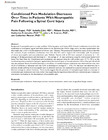Conditioned Pain Modulation Decreases Over Time in Patients With Neuropathic Pain Following a Spinal Cord Injury
dc.contributor.author
Gagné, Martin
dc.contributor.author
Cote, Isabelle
dc.contributor.author
Boulet, Melanie
dc.contributor.author
Jutzeler, Catherine
dc.contributor.author
Kramer, John L.K.
dc.contributor.author
Mercier, Catherine
dc.date.accessioned
2020-11-13T12:00:21Z
dc.date.available
2020-10-17T02:41:52Z
dc.date.available
2020-10-19T12:39:16Z
dc.date.available
2020-11-13T12:00:21Z
dc.date.issued
2020-11
dc.identifier.issn
1545-9683
dc.identifier.issn
0888-4390
dc.identifier.issn
1552-6844
dc.identifier.other
10.1177/1545968320962497
en_US
dc.identifier.uri
http://hdl.handle.net/20.500.11850/446441
dc.identifier.doi
10.3929/ethz-b-000446441
dc.description.abstract
Background
Neuropathic pain is a major problem following spinal cord injury (SCI). Central mechanisms involved in the modulation of nociceptive signals have been shown to be altered at the chronic stage, and it has been hypothesized that they might play a role in the development of chronic pain.
Objective
This prospective longitudinal study aimed to describe the evolution of pain modulation mechanisms over time after SCI, and to explore the relationships with the presence of clinical (neuropathic and musculoskeletal) pain.
Methods
Patients with an SCI were assessed on admission (n = 35; average of 38 days postinjury) and discharge (n = 25; average of 131 days postinjury) using the International Spinal Cord Injury Pain Basic Data Set. Conditioned pain modulation was assessed using the cold pressor test (10 °C; 120 s) as the conditioning stimulus and tonic heat pain, applied above the level of injury, as the test stimulus (120 s). Heat pain threshold was also assessed.
Results
A marked decrease in the efficacy of conditioned pain modulation was observed over time, with 30.2% of inhibition at admission and only 12.9% at discharge on average (P = .010). This decrease was observed only in patients already suffering from neuropathic pain at admission and was not explained by a general increase in sensitivity to thermal nociceptive stimuli.
Conclusion
These results suggest that the presence of neuropathic pain leads to a decrease in conditioned pain modulation over time, rather than supporting the hypothesis that inefficient conditioned pain modulation mechanisms are leading to the development of neuropathic pain.
en_US
dc.format
application/pdf
en_US
dc.language.iso
en
en_US
dc.publisher
SAGE
dc.rights.uri
http://creativecommons.org/licenses/by-nc/4.0/
dc.subject
conditioned pain modulation
en_US
dc.subject
heterotopic noxious counter-stimulation
en_US
dc.subject
central pain
en_US
dc.subject
longitudinal design
en_US
dc.subject
trauma
en_US
dc.title
Conditioned Pain Modulation Decreases Over Time in Patients With Neuropathic Pain Following a Spinal Cord Injury
en_US
dc.type
Journal Article
dc.rights.license
Creative Commons Attribution-NonCommercial 4.0 International
dc.date.published
2020-10-03
ethz.journal.title
Neurorehabilitation and Neural Repair
ethz.journal.volume
34
en_US
ethz.journal.issue
11
en_US
ethz.journal.abbreviated
Neurorehabilitation neural repair
ethz.pages.start
997
en_US
ethz.pages.end
1008
en_US
ethz.version.deposit
publishedVersion
en_US
ethz.identifier.wos
ethz.identifier.scopus
ethz.publication.place
Thousand Oaks, CA
ethz.publication.status
published
en_US
ethz.date.deposited
2020-10-17T02:42:02Z
ethz.source
WOS
ethz.eth
yes
en_US
ethz.availability
Open access
en_US
ethz.rosetta.installDate
2020-11-13T12:00:35Z
ethz.rosetta.lastUpdated
2024-02-02T12:29:36Z
ethz.rosetta.versionExported
true
ethz.COinS
ctx_ver=Z39.88-2004&rft_val_fmt=info:ofi/fmt:kev:mtx:journal&rft.atitle=Conditioned%20Pain%20Modulation%20Decreases%20Over%20Time%20in%20Patients%20With%20Neuropathic%20Pain%20Following%20a%20Spinal%20Cord%20Injury&rft.jtitle=Neurorehabilitation%20and%20Neural%20Repair&rft.date=2020-11&rft.volume=34&rft.issue=11&rft.spage=997&rft.epage=1008&rft.issn=1545-9683&0888-4390&1552-6844&rft.au=Gagn%C3%A9,%20Martin&Cote,%20Isabelle&Boulet,%20Melanie&Jutzeler,%20Catherine&Kramer,%20John%20L.K.&rft.genre=article&rft_id=info:doi/10.1177/1545968320962497&
Dateien zu diesem Eintrag
Publikationstyp
-
Journal Article [128874]

